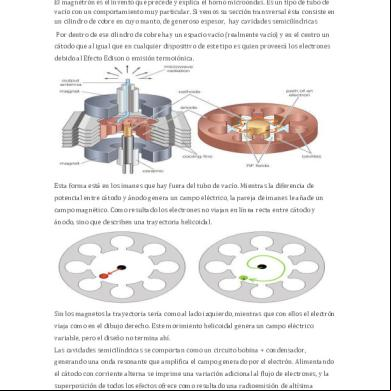Magnetron Ppt 3n5b2y
This document was ed by and they confirmed that they have the permission to share it. If you are author or own the copyright of this book, please report to us by using this report form. Report 3i3n4
Overview 26281t
& View Magnetron Ppt as PDF for free.
More details 6y5l6z
- Words: 295
- Pages: 21
CAVITY MAGNETRON -Nagendra Singh Shekhawat 09ec000597
Microwave Tubes The interaction between an Interaction electron beam and between an Ordinary gridded RF field is tube(triode at the electron beam and continuous RF field takes highest frequency) place(klystron) (TWT,MAGNETR ON)
An electric field is used to ensure that interaction between an electron beam and RF field is continuous(TWT,BWO) A magnetic field ensures a constant electron beam and RF field interaction(MAGNETRON)
Invention of Magnetron • Limitations of Ordinary Gridded Tubes -Skin Effect -Transit Angle Effect • Need of High-power microwaves
Velocity-modulated Tubes
Brief History of magnetron • 1920s:American Engineer Albert W. Hull invented the first magnetron while working for General Electric. • 1940s:Two physicists, John Randall and Harry Boot, working at the University of Birmingham, England developed a much more powerful magnetron that is compact enough to fit into ships, planes and submarines.
Cavity Magnetron
PHYSICAL STRUCTUREAnode-made of copper plates Cathode-made of high emission material Magnets Cavities Filament Leads Output antenna(waveguide) Cooling fins DC voltage source
Working of Cavity Magnetron 1.Production and Acceleration of an electron beam in a dc field
2.Velocity-modulation of the electron beam
Electron bunch formation
3.Formation of electron bunches by velocity modulation (Space-charge wheel)
4. Dispense energy to the ac field
Equations of electron motion • Hull cut-off voltage equation V0c=B02b2(1-(a/b)2)2e/8m • Hull cutoff magnetic equation B0c=(8V0m/e)1/2/ b(1-(a/b)2)
Strapping & Modes of Oscillations
Applications • Radar
Applications • Microwave ovenEverytime you warm Something in microwave oven, you use a device that helped to Change the course Of history of WW2
Applications • Sulfur Lamp
The Large Hydron Collider • Gigantic Scientific instrument near Geneva • To study the smallest known particles-the fundamental building blocks of all things.
Working Of Accelerator • Main Components 1. Radiofrequency(RF) cavities and electric fields 2. Vacuum Chamber 3. Magnets
Microwave Tubes The interaction between an Interaction electron beam and between an Ordinary gridded RF field is tube(triode at the electron beam and continuous RF field takes highest frequency) place(klystron) (TWT,MAGNETR ON)
An electric field is used to ensure that interaction between an electron beam and RF field is continuous(TWT,BWO) A magnetic field ensures a constant electron beam and RF field interaction(MAGNETRON)
Invention of Magnetron • Limitations of Ordinary Gridded Tubes -Skin Effect -Transit Angle Effect • Need of High-power microwaves
Velocity-modulated Tubes
Brief History of magnetron • 1920s:American Engineer Albert W. Hull invented the first magnetron while working for General Electric. • 1940s:Two physicists, John Randall and Harry Boot, working at the University of Birmingham, England developed a much more powerful magnetron that is compact enough to fit into ships, planes and submarines.
Cavity Magnetron
PHYSICAL STRUCTUREAnode-made of copper plates Cathode-made of high emission material Magnets Cavities Filament Leads Output antenna(waveguide) Cooling fins DC voltage source
Working of Cavity Magnetron 1.Production and Acceleration of an electron beam in a dc field
2.Velocity-modulation of the electron beam
Electron bunch formation
3.Formation of electron bunches by velocity modulation (Space-charge wheel)
4. Dispense energy to the ac field
Equations of electron motion • Hull cut-off voltage equation V0c=B02b2(1-(a/b)2)2e/8m • Hull cutoff magnetic equation B0c=(8V0m/e)1/2/ b(1-(a/b)2)
Strapping & Modes of Oscillations
Applications • Radar
Applications • Microwave ovenEverytime you warm Something in microwave oven, you use a device that helped to Change the course Of history of WW2
Applications • Sulfur Lamp
The Large Hydron Collider • Gigantic Scientific instrument near Geneva • To study the smallest known particles-the fundamental building blocks of all things.
Working Of Accelerator • Main Components 1. Radiofrequency(RF) cavities and electric fields 2. Vacuum Chamber 3. Magnets










